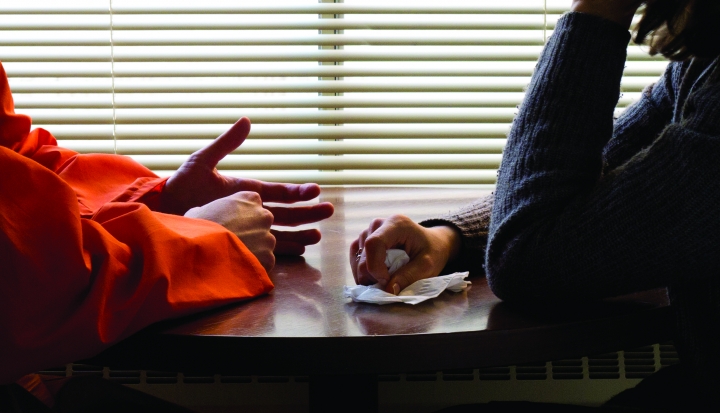With U.S. incarceration rates at an unsustainable high, crime victims are taking the lead in an effort to rehabilitate offenders.
Lonnie Jones was just 16 years old when he and a group of friends planned to burglarize an empty home in hopes of making some easy money. They broke into the dark house around 9 p.m. and had nearly completed the robbery when the owner suddenly walked in. As she stood in the doorway and screamed, Jones and his friends panicked. One of the robbers grabbed the woman and another pulled out a knife, stabbing her and leaving her to die as the group fled the scene.
“It was just out of fear,” says Jones, looking back on his crime more than three decades later. “I was just a kid. We didn’t want to hurt anybody.”
Jones was arrested soon after and convicted of murder. Despite his remorse for the terrible consequences of the robbery gone wrong—and being only a minor—he was given a sentence of life in prison plus an additional 109 years. He was then sent to a Texas prison to live out the remainder of his days behind bars.
It was nearly 30 years before Jones, through a coincidental encounter with a former federal judge who pulled some strings on his behalf, was put on a path to parole. He entered a pre-release program in 2007, during which he signed up for a 14-week course called Bridges to Life.
The program, one of a growing number of restorative justice initiatives taking place in prisons around the country, brings together offenders and victims of violent crime in the hope of fostering healing and rehabilitation. In a correctional system struggling to deal with massive overcrowding, budget shortfalls, and high rates of recidivism, restorative justice is offering a new way forward for American prisons.
Bridges to Life was founded by John Sage, whose own life was changed by a crime very similar to the one committed by Jones. In 1993 Sage’s sister, Marilyn, was murdered by two teenagers during a burglary. The killers were tried in a Texas court, convicted, and sentenced to death, but even seeing the perpetrators receive the ultimate punishment wasn’t enough to console Sage. The loss of his sister sent him on an emotional downward spiral, and nothing in the justice system could help him find solace.
“When you think about the evil of someone killing someone you love, you are kind of staring Satan in the eye,” says Sage, a soft-spoken Houston native and lifelong Catholic. “I became a prisoner of all those emotions—anger, revenge, just wanting to hurt somebody. So I was searching for a way to dig out of that hole.”
It took Sage nearly five years to work through the trauma of his sister’s murder. He was then invited to participate in a pilot program, developed by Prison Fellowship International, that connected victims and offenders. It proved to be a life-changing experience. The more he learned about restorative justice—which seeks to repair the harm done by crime for all parties involved rather than simply punish the offender—the more Sage felt that such an approach was needed on a larger scale.
Drawing from his personal experience and the pilot program in which he volunteered, Sage developed a curriculum for Bridges to Life. Though it is not intended to convert participants, he says, it does rely heavily on Christian themes such as repentance, reconciliation, and forgiveness.
Inmates and volunteers meet for two-hour sessions that include small group discussions and testimonies from victims, who discuss the ways in which crimes like rape and murder have drastically altered their lives. Participants complete weekly homework assignments and must share their own stories with the group, often taking responsibility for their crimes for the first time.
“It takes [offenders] outside of themselves and shows them what they’ve done and who they’ve hurt,” says Sage, whose program has now been used in 28 Texas prisons with more than 16,500 inmates completing the course. “We let them talk in a safe place where they can express themselves, express their emotions. This is a counter-culture to the prison.”
That approach appealed to Jones, who found the program to be in stark contrast to anything he’d experienced in three decades of living under the supervision of the Texas Department of Corrections.
“Everything in prison is either run by guards or someone from the state, and their first priority is always security. Their first thought is ‘This is an inmate,’” he says. “But Bridges to Life, their first priority is getting you to understand what went wrong, where it went wrong, how it affects others, and how it affected you. It just touches a place that other programs in prison, they don’t even go there.”
Jones completed the program and, still awaiting release, asked if he could enroll a second time. He then participated a third and a fourth time, eventually becoming an honorary teacher and counseling his fellow inmates before finally being granted his release from prison in 2009, 31 years after his arrest.
“That program did for me, and for the other guys I have seen go through it, what nothing else in prison could have done,” says Jones, now 50. “There’s no way you can just sit there and talk to someone that has been affected by crime, someone that has went through something as traumatic as a rape or a loved one’s murder—there’s no way you can look them in the eyes and not be affected.”
Crime and punishment
The restorative justice movement began in the 1970s in response to what some saw as an alarming trend toward ever more punitive responses to crime. With initiatives such as the “war on drugs,” policymakers vowed to be “tough on crime,” and the justice system began to emphasize harsh sentencing for even minor offenses as a supposed deterrent to criminal behavior. More offenders were sentenced to longer prison stays, resulting in a system where one in every 104 Americans is now behind bars.
“It seems the rubber band has stretched about as far as it can on a purely punitive philosophy,” says Andrew Skotnicki, a religious studies professor at Manhattan College whose books on criminal justice include The Last Judgment: Christian Ethics in a Legal Culture (Ashgate). “We still have a very strong retributive philosophy and believe that people go to prison in order to be punished. But at the same time I think we’re beginning to question that mentality, because it has produced the most imprisoned people on earth.”
According to the latest numbers from the Bureau of Justice Statistics, the United States had 2.3 million citizens in federal, state, or local jails at the end of 2010. (China, with 1.6 million prisoners, is the only country whose inmate population comes close to that of the United States.) The federal and state prison population alone has more than doubled in the last 20 years, growing from 740,000 in 1990 to more than 1.6 million in 2010.
Prison overcrowding has resulted in corrections budgets being stretched to their limits. The average cost of keeping an inmate incarcerated for one year is $29,000, and the Center for Economic and Policy Research reports that federal, state, and local governments combined spent nearly $75 billion on corrections in 2008.
“If for no other reason than economics, we have completely run the penal ship aground,” says Skotnicki. “We know it is not working, and we are dying for somebody to give us a good idea that is cost-effective and that ultimately has redemptive effects that change people’s lives.”
That was the goal for a group of Mennonite researchers who began looking for alternative solutions to criminal justice issues in the mid-1970s. Howard Zehr, who joined the movement in 1978, says that prison overcrowding was already becoming a concern. “But we had no concept of how bad it was really going to get,” he says.
Zehr, often called the “grandfather of restorative justice,” found that punitive approaches to justice were not truly holding offenders accountable and that the threat of punishment made offenders feel as if they were the victims. Meanwhile the actual victims’ needs were being neglected and the community at large was being shut out of the process.
“When I started listening to victims and then seeing what happened when victims and offenders met, it shook up my whole view on justice,” says Zehr, a professor of restorative justice at Eastern Mennonite University in Harrisonburg, Virginia. He came to the conclusion that the traditional questions asked by the justice system—what laws have been broken, who is to blame, and how they should be punished—were not the best approach for the offender, the victim, or the community.
“A fundamental change [with restorative justice] is that we’d be asking different questions,” Zehr says. “We would be saying not, ‘What punishment does this offender deserve?’ but ‘How can we resolve this thing in a way that is as healing as possible, as helpful as possible for everybody involved, while holding the offender adequately accountable?’ And that’s a different question [from the one] we’re asking.”
Shock to the system
In the last three decades, the new approach pioneered by Zehr has been applied in a number of different ways. In some cases, restorative justice can serve as an alternative method of sentencing, bringing together the offender and their victims to discuss the details of the crime and how best to resolve it, which may or may not result in a prison sentence.
Other programs, like the one developed by Sage, bring inmates into conversation with victims of other crimes—“surrogate victims,” as they are sometimes called—providing an opportunity for both parties to heal and preparing inmates for their eventual release. Though restorative justice programs come in many shapes and sizes, they share a similar goal of addressing the consequences of crime in a way that seeks to repair, as best as possible, the harm that has been done.
Janine Geske, a former Wisconsin Supreme Court Justice who now serves as director of the Restorative Justice Initiative at Marquette University, has experimented with a variety of restorative justice models over the past 12 years. She has brought together perpetrators of violent crime and their victims for one-on-one conversations and runs three-day prison workshops that bring together inmates, community members, and crime victims.
These experiences, says Geske, can be transformational for all involved. That doesn’t mean, however, that restorative justice guarantees rehabilitation, or even that inmates who participate would not commit another offense if released. “It is more complicated than that,” Geske says. “But I do think you can change people’s motivation and you can change how people think about [crime].”
At Green Bay Correctional Institution, a maximum security prison in Wisconsin where Geske has been running her program the longest, Warden Michael Baenen says restorative justice programming has deeply affected the institution’s climate. Inmates who participate have fewer behavioral problems, he says, making the prison safer. Others have been inspired to suggest community service projects or charity fundraisers they can run from inside the prison. Some have even taken to working in the prison’s garden to grow fresh produce for local food pantries.
“Once they can start thinking about the impact of what they do, it just seems to open a gate of being willing to look at different ways of running your life,” Baenen says. That’s a big help for those who are preparing for reentry into the community, he adds, but it also holds true for those who are never going to be released.
“They are still human beings and they have a positive impact on other people who are going home,” Baenen says. “In some cases they are parents and have an impact on their children. So yes, there are definitely benefits.”
Tougher on crime
But in a system that has been built on the idea of punishing offenders, not everyone is on board with the concept of restorative justice. “Sometimes I hear law enforcement call it ‘hug a thug,’” says Geske.
Critics of the model argue that it is “soft on crime” and goes easy on offenders, which Geske argues couldn’t be further from the truth. “This process is harder on them than almost any other program you can give them,” she says. “This really calls them to be responsible for victimizing others and having hurt others in ways they never considered.”
That’s especially true when the offender sits down with the people who were directly affected by their actions. Geske recalls family members showing a murderer a photo of their victim in a casket, or reading to them from the autopsy report. “That is tough stuff for an offender to sit and listen to, which they’ve never had to do before,” she says. “So there is nothing easy about restorative justice.”
Sage also encountered some resistance when he began pitching Bridges to Life to prisons. “At first they thought we were nuts,” he says with a laugh. Wardens told him that there was no such thing as a confidential meeting in prison, and once they started running the program it was often interrupted by guards. But in time Sage’s efforts came to be more accepted by the prison system.
“We had a lot of barriers to overcome in the first few years, and we still do,” says Sage. “But I think there’s been a lot of work done in Texas and all around the country in people understanding we’ve got to do something different, and I think the leadership in the prison system in the last 10 years has affected some real attitude changes.”
Part of that change is due to the programs’ proven success. Nationwide recidivism rates have remained high for the last decade, with a 2011 study by the Pew Center on the States finding that roughly 45 percent of offenders released from state prisons return to the system within three years. But a study of more than 1,000 Bridges to Life graduates released from 14 different prisons between 2005 and 2008 shows a recidivism rate of 18.7 percent, less than half of the national average. “We can’t take 100 percent credit (for that number),” admits Sage, “but I know that we are a big piece of the reason.”
Many in the prison system have taken notice. Sage’s curriculum has been adapted for use in 10 states, and restorative justice programming has been instituted in prisons nationwide. In California, where the prison population peaked in 2006 at 173,000—double the number of inmates the system was built to hold—such programs have been in high demand.
“In different facilities the people at the top are very anxious to have some type of restorative process,” says Jesuit Father Michael Kennedy, executive director of the California-based Jesuit Restorative Justice Initiative. Working in prisons ranging from San Quentin down to small juvenile facilities, Kennedy has helped to implement such programs and has seen increasingly positive results among participants.
And since most programs are run by volunteers and supported through donations or underwriters, they come at little or no cost to the state. In a system looking for cost-effective solutions to rehabilitate offenders and cut down on recidivism, economics may be the strongest selling point for restorative justice, says Kennedy. “We wouldn’t even be having this conversation if it wasn’t for money,” he says.
Still, that doesn’t mean everyone has jumped on the restorative justice bandwagon. “Are there some people who are totally against it? Of course there are,” Kennedy says. “We’re always going to have that. But the fact of the matter is, it works.”
Second chances
Another common misconception about restorative justice is the belief that it would somehow replace prisons or result in dangerous criminals being released. But proponents of prison reform such as Manhattan College’s Skotnicki argue that there are some criminals who absolutely need to be kept behind bars to ensure public safety. Even so, he says, that doesn’t mean society should give up on them. Instead, restorative justice advocates argue for a system that focuses more on rehabilitation rather than revenge.
“The fundamental junction between what’s wrong with the prison system and what’s right with restorative justice goes to respect for the human person,” says Scott Wood, director of the Center for Restorative Justice at Loyola Law School in Los Angeles. Wood points to harsh sentencing laws like California’s “three strikes” policy, which requires an offender to receive a life sentence upon a third conviction, as a major flaw in the current system. According to the Insight Prison Project, California had more than 3,000 prisoners serving life sentences at the end of 2009 for nonviolent offenses under the three strikes law, though some may have hope of a revised sentence after a 2012 voter referendum authorized changes to the three strikes law.
“To me, what we’ve done with these sentencing laws is simply thrown people away,” Wood says. “Restorative justice on the other side begins with the proposition that every life has worth and great value, so we proceed with a very respectful attitude toward locating the harm that’s been done to human relationship through crime and trying to figure out some way to repair that harm or put people back in right relationship.”
Finding ways to make amends for the damage his crime caused has now become a top priority for ex-offender Lonnie Jones. “I know it is hard to do. You can’t bring back a life,” he says. “But I am trying to do the right thing. I know I can’t please everybody, but I do what I can.”
Jones has been working two jobs, trying to make ends meet and to save for his eventual retirement. He managed to buy a house and met a woman whom he plans to marry this year. But such personal gains are secondary to his efforts to help others. Jones makes time to visit juvenile detention centers to talk to young people about the choices they make and looks for ways to reach out to anyone who might be in need. “That’s my way of giving back for what I’ve done,” he says.
Jones credits Bridges to Life with getting him on the right track, as it has done for many other ex-offenders. If it were up to him, he says, the program would be a requirement for every inmate prior to parole.
Restorative justice proponents like Janine Geske share Jones’ hope for the future. She continues to work toward larger acceptance of restorative justice practices, including finding new ways to implement them in different situations that might help reduce or even prevent the spread of crime.
“I understand that there are lots of good parts to the criminal justice system, and I certainly wouldn’t throw it out,” says Geske. “I just think [if we] find ways to have people talk and listen to each other and better understand one another, we’re much less likely to hurt each other.”
Want to read more? See the web-only sidebars that accompany this article about a mother’s struggle with her son’s incarceration and restorative justice in New Zealand.
This article appeared in the March 2013 issue of U.S. Catholic (Vol. 78, No. 3, pages 12-17).
Image: Tom A. Wright













Add comment